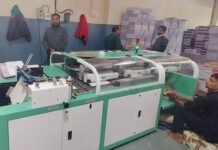Fujifilm Business Innovation has developed not one but two roll-to-roll versions of the inkjet Jet Press, building on the existing sheetfed Jet Press 750 series with a similar printing system but different inks. Both of these were sort of announced at IGAS though neither machine was at the show.
The two versions use very similar hardware and offer the same basic specifications. Thus, these are twin engined presses for duplexing and take 520.7 mm wide paper rolls. They use Fujifilm Dimatix printheads with 1200 x 1200 dpi resolution and print CMYK using water-based pigment inks. After printing, the paper path goes around a heated drum and then turns back on itself, passing underneath the print tower before exiting for either the second unit or the rewinder. As well as the heated drum, warm air is wafted around to help dry the ink without removing too much moisture from the paper.
The main difference between the two models is the ink set. The 1160CF – or Continuous Feed – uses what Fujifilm describes as a “newly developed high concentration pigment ink” which has been designed for uncoated and plain paper, where the paper can absorb some of the water content in the ink to reduce the amount of drying needed. It can run at 160 meters per minute at 1200 x 600 dpi – around 2096 A4ppm – or 80 meters per minute in its Image Quality mode at 1200 x 1200 dpi. This model takes 64 to 250gsm paper, though the press will slow down for media over 157 gsm. This version should warm up to operating temperature in 15 minutes.
The 2150CFG – Continuous Feed Graphics – has been designed for printing to offset paper without needing any kind of inkjet treatment or precoating. This press uses a different water-based pigment ink, which Fujifilm described to me as being a “sticky” ink where the ink is designed to hold the shape of the dots to give a sharper image and prevent any spreading into the substrate.
This press also appears to have gained an infra red heating unit, which the paper passes through before reaching the heated drum. Each of the print units is slightly bigger than the 1160CF, which presumably is also to accommodate a longer paper path to expose the media to hot air over a longer period to help with drying the water content from the ink.
As such it is aimed primarily at graphics applications, such as books and magazines. It’s maximum speed is slightly slower at 150 meters per minute or 1968 A4 pages per minute on uncoated paper, but it can run this at the top resolution of 1200 x 1200 dpi. This speed drops to 120 meters per minute on coated matte paper. The Standard print mode can deliver 80 meters per minute and there’s an Image Quality mode that runs at 50 meters per minute. It takes paper from 64 to 157gsm. It needs around 20 minutes at room temperature to warm up before printing.
These presses use a Fujifilm digital front end, based on the Adobe PDF Print Engine. The ink is supplied in 20 kilogram packs per color, and both presses have a large ink buffer tank so that the presses can be refilled on the fly.
For now, Fujifilm is only selling these presses in Japan though it seems likely to me that there would be strong demand for both of these in the US and European markets. Naturally, Fujifilm was not ready to talk about pricing though the 1160CF has been available now for a week.
It’s also worth noting that Fujifilm announced the high speed version of the cut sheet Jet Press, the 750HS, as a new model for the Japanese market, though this was introduced into Europe last year. You can find further details from fujifilm.com.
This article is reprinted by permission from www.nessancleary.co.uk.
















